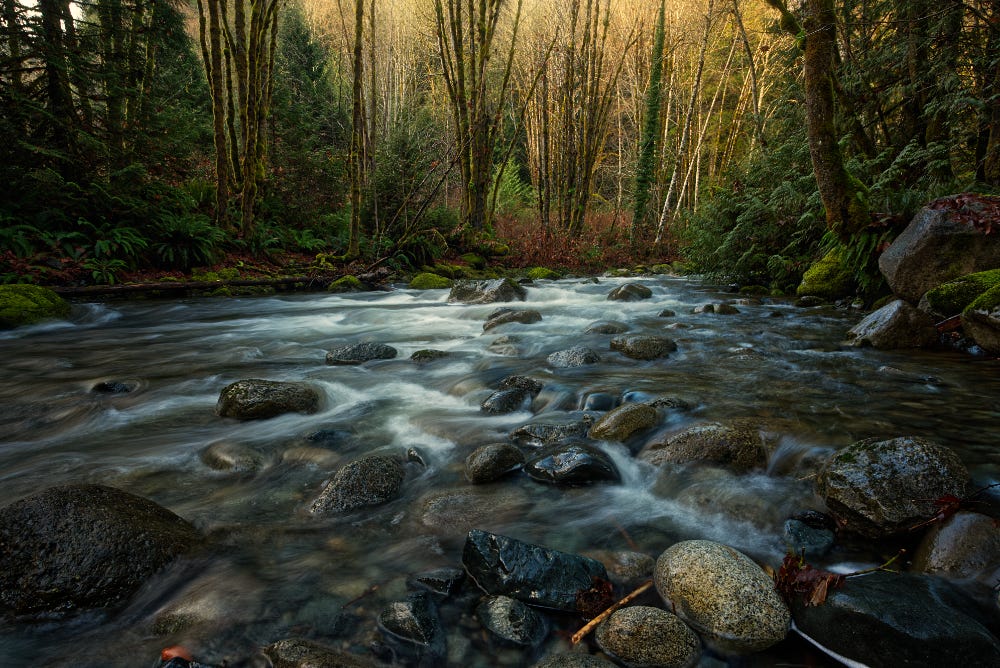Meaning of the term: Still in the Stream
Still in the stream is a term I started using after reading about “stream enterers.” In some schools of Buddhism, stream enterers are people who fully understand the Four Noble Truths and have committed to being a good, kind, compassionate person. The path they take is one of abandonment and letting go. Letting go of the idea of a permanent self, letting go of misgivings and doubt, and letting go of attachment to rules and vows. Conversely, they embrace a unity view of all things, faith in the spiritual endeavor, and development of a principled approach to ethics within a community of fellow stream enterers. This is, of course, my interpretation of the meaning, uncoupled from the historic and cultural language. When I combine it with that of the Christian disciple, the one who has given up self through ritual purification with water (baptism) I get a nicely rounded ideal to guide me.
Ichnographically, both traditions place the entry of water as a central image, with it’s connotations of washing, cleansing, and flowing. In the Buddhist tradition water symbolizes purification, fluidity, and the dissolution of rigid ego-boundaries. In the Christian tradition it symbolizes dying to the old self, referred to in some traditions as the false self, and emerging out of the water to a new life.
One problem with both traditions is that they mark this transition as one into “the true view” or even “the truth,” and this idea that one traditions has the “really right” view of things leads to a sort of arrogance about the group that I find counterproductive for true personal and spiritual growth.
A popular Christian song when I was growing up included the lyrics, “Jesus is the answer for the world today, above him there’s no other, Jesus is the way.” While I understand how we as humans like to think we have found “the way” my heart also resonates with another song, U2’s “I still haven’t found what I’m looking for.” It also goes too far, of course because I have found much of what I’m looking for, but neither Christianity nor Buddhism have held all the pieces for me. In this sense, I am not a stream enterer. I am not committed to Buddhism as the only path. And for most Christians, suggesting that Jesus is not “The Way” is heresy.
This is what makes me, “still in the stream;” still entering and still emerging, still swimming and still treading water. Life in the stream is sometimes still, but sometimes turbulent. So the goal for me now is to develop an inner stillness even when the stream is a raging torrent, carrying me towards a down-stream destination that is uncertain and scary, especially as the stream swells into a river.
P.T. Mistlberger in his book, Rude Awakening, says that the word translated as Zen, Cha’an, and dhyana are sometimes translated in English as meditation but, “In fact [the original] carries complex meaning, denoting various levels of progressive deepening of meditation, but the essence of the meaning of the word is to ‘join with the flow’ of each moment. This is a key insight because in the realm of experience, there actually is no ‘now’, because all is in perpetual flux, perpetual change, like a moving river. the only thing static is consciousness itself. To meditate, in the true sense of the word, is to move beyond the constant change of existence, into the immutable and crystal-clear nature of pure awareness.”
This idea of pure awareness within the ever changing river of existence is very akin to what i mean by “still in the stream.”
My blog posts cover a variety of topics, but most of them swirl around this central idea of being open to more, being curious about spirituality, and exploring the nuances that reveal truth. Tim Urban famously said, “Truth is in the nuance,” and I could not agree more.
If this life of living still, in the stream, is one that resonates with you, then please let me know in the comments about your experiences. How have you managed it, what do you recommend?

